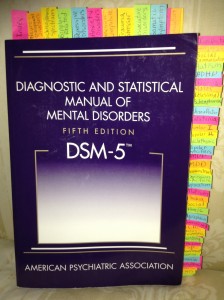 Yes, this photo is of my personal copy of the DSM-5, as it looked during my open-book midterm exam this past week. It’s been a long while since I’ve found the time to post here, as graduate school has been particularly demanding this semester. I was thinking though — Why not better integrate my grad school experience with this blog? I’ve featured several others’ perspectives on the DSM-5, so why not include my own as I dive into the manual throughout my Diagnosis & Treatment Planning class? Without further ado, my reflections on the introductory section:
Yes, this photo is of my personal copy of the DSM-5, as it looked during my open-book midterm exam this past week. It’s been a long while since I’ve found the time to post here, as graduate school has been particularly demanding this semester. I was thinking though — Why not better integrate my grad school experience with this blog? I’ve featured several others’ perspectives on the DSM-5, so why not include my own as I dive into the manual throughout my Diagnosis & Treatment Planning class? Without further ado, my reflections on the introductory section:
The introductory chapter to the DSM-5 was helpful in providing some historical and scientific context for the manual. I appreciated that both the virtues and limitations of using DSM criteria were discussed, and that the APA envisions the DSM as a “living document” that will adapt to future research developments. However, I was struck by the fact a biomedical model of mental disorders (i.e., understanding mental disorders in terms of disease, symptoms, treatment, etc.) was presented implicitly, as if the validity of such an approach is beyond doubt. Given that the APA is a group of psychiatrists, i.e., medical doctors, it was not surprising to see medical language and metaphors (such as “eventual cures,” “disease origins,” “course of illness,” “biomarkers,” and “shared neural substrate”) sprinkled throughout the introductory remarks. As someone with a humanistic, biopsychosocial orientation to health (mental, physical, and societal), I am not comfortable with the DSM’s implicit view of psychological distress as ultimately a matter of “underlying pathophysiological processes” that will someday be understood by medical science. Although the complexities and psychosocial dimensions of human experience and behavior are acknowledged as influential factors affecting symptom expression and disease progression, the underlying biomedical view is taken for granted. In describing the DSM-5 as a “living document,” the authors acknowledge a certain kind of openness to change and revision, but they mention only the medical sciences of neurobiology, genetics, and epidemiology as potential sources of new knowledge. As with previous revisions of the DSM, the DSM-5 Task Force acknowledges the flaws of the previous versions of the manual and offers improvements, but I can’t help but wonder if the limitations of conventional psychiatric diagnosis and treatment are to be found through a more thorough examination of the fundamental philosophical assumptions underlying the field. I will be pondering this throughout the class.
I was surprised that the term “mental disorder” was not defined until page 20, because it seems to me that the entire prior discussion was dependent upon that definition. I found it interesting to note that expectable responses to stressors as well as socially deviant behaviors resulting from conflicts between individuals and society were defined as NOT being mental disorders. The authors also stressed the need for expert clinical judgment in differentiating between diagnostic criteria and “normal life variation” and “transient responses to stress,” and I found myself wondering how such a line between normal and pathological could ever be defined with any degree of scientific certainty. While the authors acknowledge these and other thorny issues inherent in psychiatry, they maintain that their approach is the best available system for supporting clinicians and researchers in the field of mental health. I have my doubts. From what I understand from reading Section I of the DSM-5 along with various outside critiques, the manual was not subject to a truly “independent” review process, as the Scientific Review Committee (SRC) given the task of review was established by the DSM-5 Task Force itself. Also, the manual purports to have avoided conflict of interest by requiring income disclosure of its 28 task force members, neglecting to mention what the majority of members actually disclosed—i.e., their direct financial ties to the pharmaceutical industry.
One thing I was unclear about is how the DSM-5 presumes to integrate the categorical diagnostic system of previous editions (which it criticizes as being untenable and incongruent with clinical realities) with a new “dimensional” approach to diagnosis that transcends categories. The Cross-Cutting Symptom Measure (an “emerging” assessment measure described in Section 3 of the manual) seems to be an interesting and useful way to integrate a dimensional analysis into the diagnostic and treatment process. I suppose it will eventually become clearer to me, as I read through the various diagnostic criteria, just how to integrate the dimensional and categorical perspectives.

